Analysis of Use Case Diagrams for Torrens University System Design
VerifiedAdded on 2023/01/19
|6
|1061
|88
Homework Assignment
AI Summary
This assignment focuses on the analysis of a use case diagram within the context of Principles of Programming, specifically addressing a scenario presented by Torrens University Australia for a new enrollment and timetabling system. The assignment delves into the understanding of UML diagrams, their role in visualizing system workflows, and their importance in communicating system requirements to programmers. The main body of the assignment includes a detailed examination of the provided use case diagram, assessing its suitability for conveying high-level requirements. Furthermore, it offers constructive criticism, suggesting improvements for future use case diagram development, emphasizing the identification of actors, use cases, and their relationships. The assignment also provides references to relevant literature, including books and journals, to support the analysis and understanding of the concepts discussed.
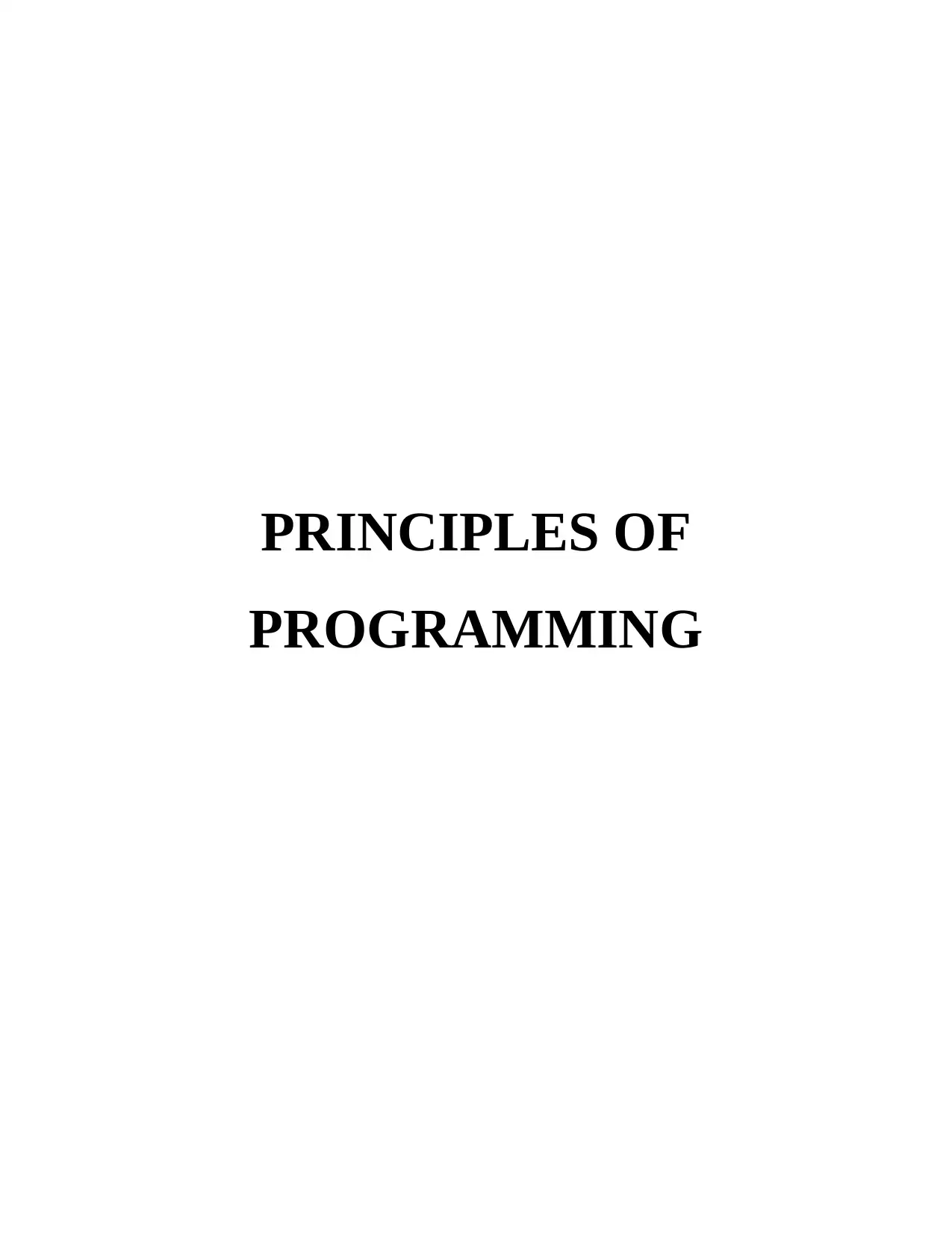
PRINCIPLES OF
PROGRAMMING
PROGRAMMING
Paraphrase This Document
Need a fresh take? Get an instant paraphrase of this document with our AI Paraphraser
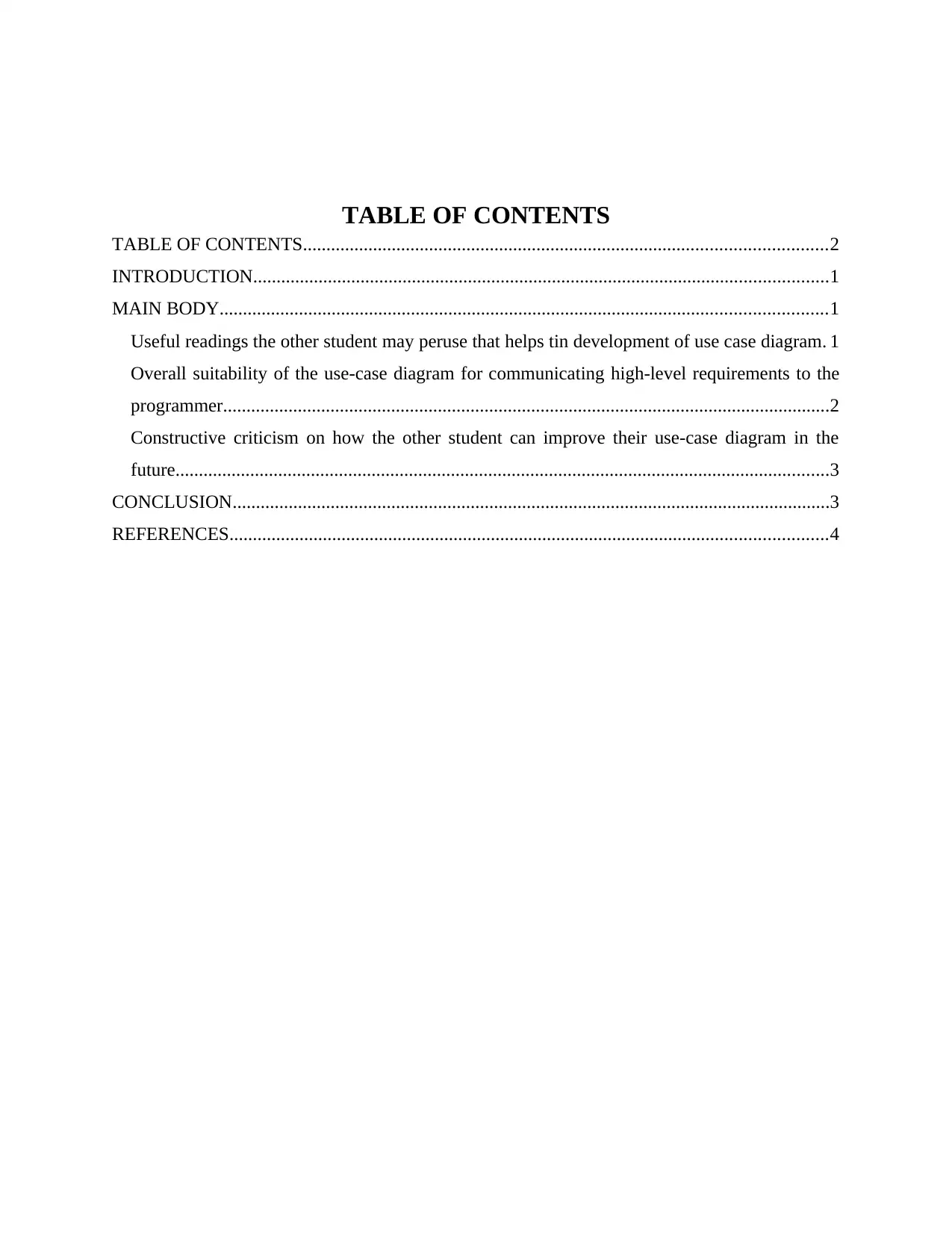
TABLE OF CONTENTS
TABLE OF CONTENTS................................................................................................................2
INTRODUCTION...........................................................................................................................1
MAIN BODY..................................................................................................................................1
Useful readings the other student may peruse that helps tin development of use case diagram. 1
Overall suitability of the use-case diagram for communicating high-level requirements to the
programmer..................................................................................................................................2
Constructive criticism on how the other student can improve their use-case diagram in the
future............................................................................................................................................3
CONCLUSION................................................................................................................................3
REFERENCES................................................................................................................................4
TABLE OF CONTENTS................................................................................................................2
INTRODUCTION...........................................................................................................................1
MAIN BODY..................................................................................................................................1
Useful readings the other student may peruse that helps tin development of use case diagram. 1
Overall suitability of the use-case diagram for communicating high-level requirements to the
programmer..................................................................................................................................2
Constructive criticism on how the other student can improve their use-case diagram in the
future............................................................................................................................................3
CONCLUSION................................................................................................................................3
REFERENCES................................................................................................................................4
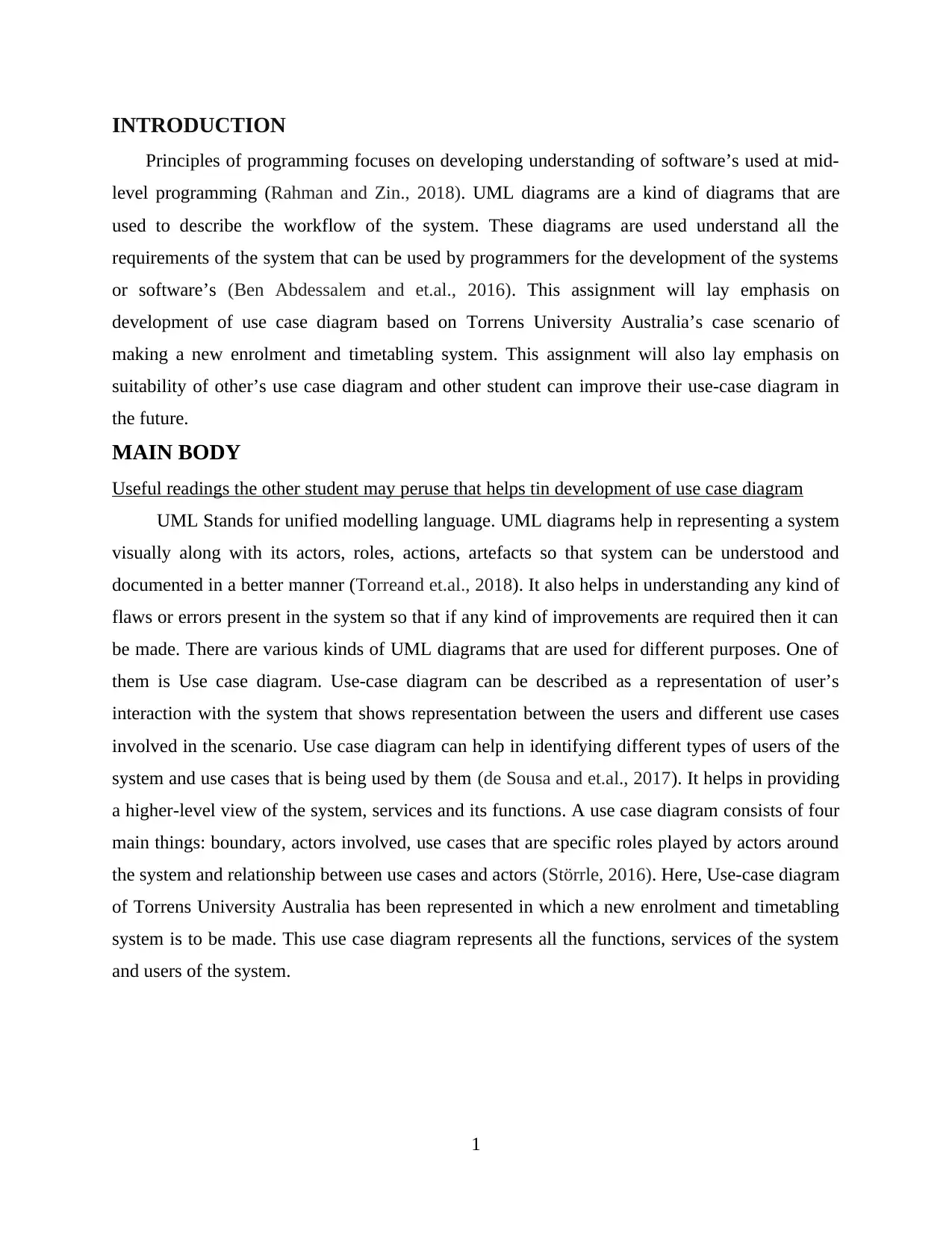
INTRODUCTION
Principles of programming focuses on developing understanding of software’s used at mid-
level programming (Rahman and Zin., 2018). UML diagrams are a kind of diagrams that are
used to describe the workflow of the system. These diagrams are used understand all the
requirements of the system that can be used by programmers for the development of the systems
or software’s (Ben Abdessalem and et.al., 2016). This assignment will lay emphasis on
development of use case diagram based on Torrens University Australia’s case scenario of
making a new enrolment and timetabling system. This assignment will also lay emphasis on
suitability of other’s use case diagram and other student can improve their use-case diagram in
the future.
MAIN BODY
Useful readings the other student may peruse that helps tin development of use case diagram
UML Stands for unified modelling language. UML diagrams help in representing a system
visually along with its actors, roles, actions, artefacts so that system can be understood and
documented in a better manner (Torreand et.al., 2018). It also helps in understanding any kind of
flaws or errors present in the system so that if any kind of improvements are required then it can
be made. There are various kinds of UML diagrams that are used for different purposes. One of
them is Use case diagram. Use-case diagram can be described as a representation of user’s
interaction with the system that shows representation between the users and different use cases
involved in the scenario. Use case diagram can help in identifying different types of users of the
system and use cases that is being used by them (de Sousa and et.al., 2017). It helps in providing
a higher-level view of the system, services and its functions. A use case diagram consists of four
main things: boundary, actors involved, use cases that are specific roles played by actors around
the system and relationship between use cases and actors (Störrle, 2016). Here, Use-case diagram
of Torrens University Australia has been represented in which a new enrolment and timetabling
system is to be made. This use case diagram represents all the functions, services of the system
and users of the system.
1
Principles of programming focuses on developing understanding of software’s used at mid-
level programming (Rahman and Zin., 2018). UML diagrams are a kind of diagrams that are
used to describe the workflow of the system. These diagrams are used understand all the
requirements of the system that can be used by programmers for the development of the systems
or software’s (Ben Abdessalem and et.al., 2016). This assignment will lay emphasis on
development of use case diagram based on Torrens University Australia’s case scenario of
making a new enrolment and timetabling system. This assignment will also lay emphasis on
suitability of other’s use case diagram and other student can improve their use-case diagram in
the future.
MAIN BODY
Useful readings the other student may peruse that helps tin development of use case diagram
UML Stands for unified modelling language. UML diagrams help in representing a system
visually along with its actors, roles, actions, artefacts so that system can be understood and
documented in a better manner (Torreand et.al., 2018). It also helps in understanding any kind of
flaws or errors present in the system so that if any kind of improvements are required then it can
be made. There are various kinds of UML diagrams that are used for different purposes. One of
them is Use case diagram. Use-case diagram can be described as a representation of user’s
interaction with the system that shows representation between the users and different use cases
involved in the scenario. Use case diagram can help in identifying different types of users of the
system and use cases that is being used by them (de Sousa and et.al., 2017). It helps in providing
a higher-level view of the system, services and its functions. A use case diagram consists of four
main things: boundary, actors involved, use cases that are specific roles played by actors around
the system and relationship between use cases and actors (Störrle, 2016). Here, Use-case diagram
of Torrens University Australia has been represented in which a new enrolment and timetabling
system is to be made. This use case diagram represents all the functions, services of the system
and users of the system.
1
⊘ This is a preview!⊘
Do you want full access?
Subscribe today to unlock all pages.

Trusted by 1+ million students worldwide
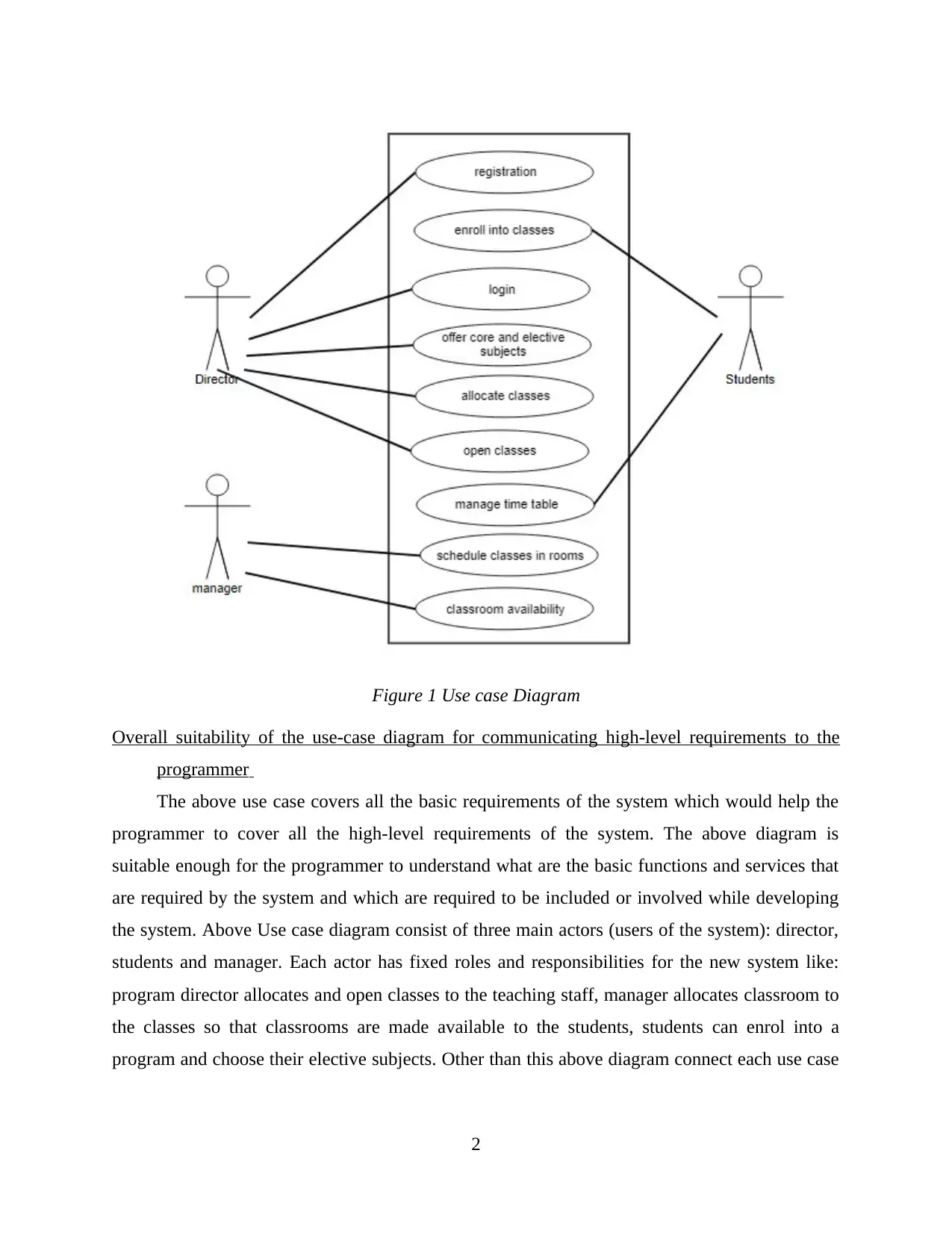
Figure 1 Use case Diagram
Overall suitability of the use-case diagram for communicating high-level requirements to the
programmer
The above use case covers all the basic requirements of the system which would help the
programmer to cover all the high-level requirements of the system. The above diagram is
suitable enough for the programmer to understand what are the basic functions and services that
are required by the system and which are required to be included or involved while developing
the system. Above Use case diagram consist of three main actors (users of the system): director,
students and manager. Each actor has fixed roles and responsibilities for the new system like:
program director allocates and open classes to the teaching staff, manager allocates classroom to
the classes so that classrooms are made available to the students, students can enrol into a
program and choose their elective subjects. Other than this above diagram connect each use case
2
Overall suitability of the use-case diagram for communicating high-level requirements to the
programmer
The above use case covers all the basic requirements of the system which would help the
programmer to cover all the high-level requirements of the system. The above diagram is
suitable enough for the programmer to understand what are the basic functions and services that
are required by the system and which are required to be included or involved while developing
the system. Above Use case diagram consist of three main actors (users of the system): director,
students and manager. Each actor has fixed roles and responsibilities for the new system like:
program director allocates and open classes to the teaching staff, manager allocates classroom to
the classes so that classrooms are made available to the students, students can enrol into a
program and choose their elective subjects. Other than this above diagram connect each use case
2
Paraphrase This Document
Need a fresh take? Get an instant paraphrase of this document with our AI Paraphraser
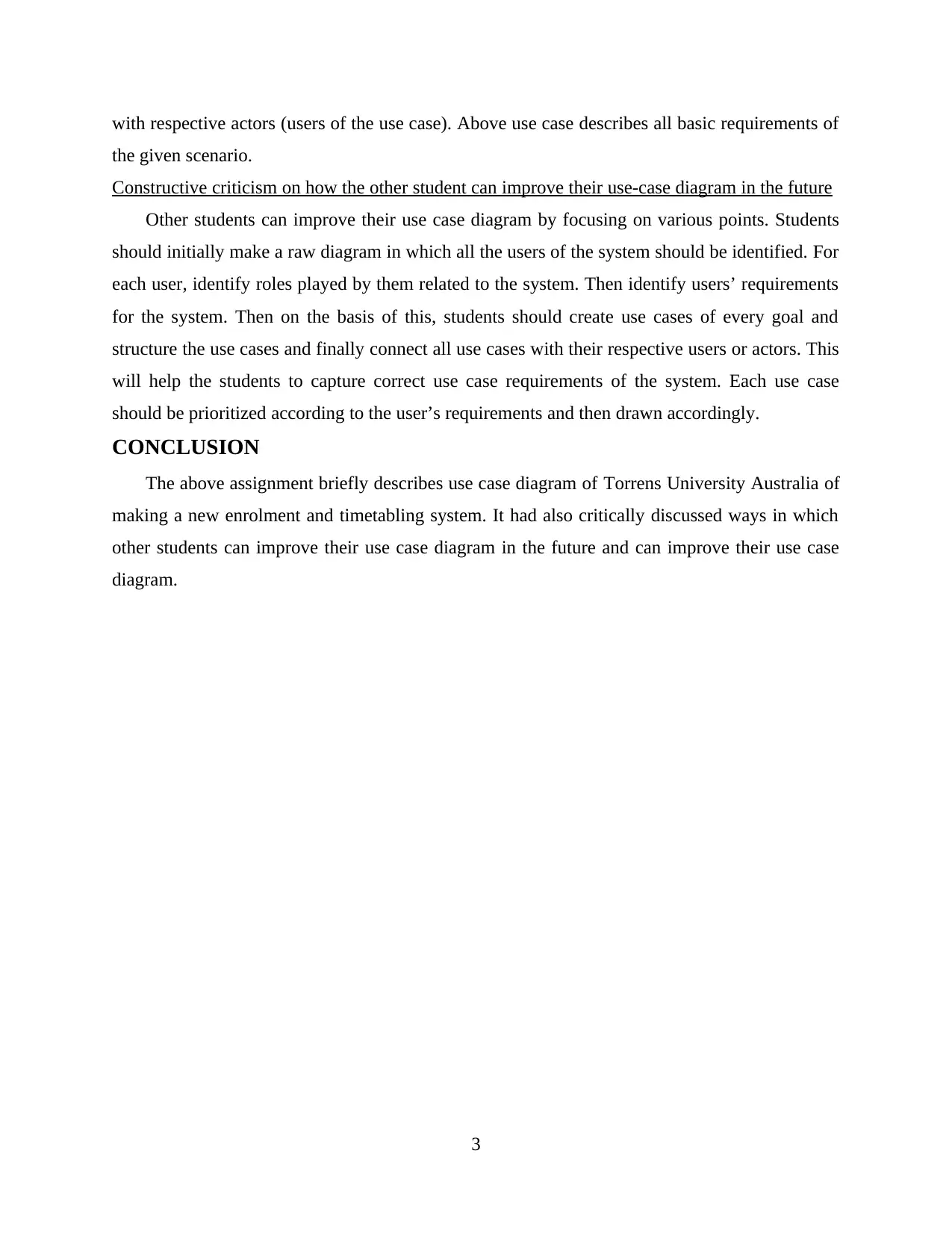
with respective actors (users of the use case). Above use case describes all basic requirements of
the given scenario.
Constructive criticism on how the other student can improve their use-case diagram in the future
Other students can improve their use case diagram by focusing on various points. Students
should initially make a raw diagram in which all the users of the system should be identified. For
each user, identify roles played by them related to the system. Then identify users’ requirements
for the system. Then on the basis of this, students should create use cases of every goal and
structure the use cases and finally connect all use cases with their respective users or actors. This
will help the students to capture correct use case requirements of the system. Each use case
should be prioritized according to the user’s requirements and then drawn accordingly.
CONCLUSION
The above assignment briefly describes use case diagram of Torrens University Australia of
making a new enrolment and timetabling system. It had also critically discussed ways in which
other students can improve their use case diagram in the future and can improve their use case
diagram.
3
the given scenario.
Constructive criticism on how the other student can improve their use-case diagram in the future
Other students can improve their use case diagram by focusing on various points. Students
should initially make a raw diagram in which all the users of the system should be identified. For
each user, identify roles played by them related to the system. Then identify users’ requirements
for the system. Then on the basis of this, students should create use cases of every goal and
structure the use cases and finally connect all use cases with their respective users or actors. This
will help the students to capture correct use case requirements of the system. Each use case
should be prioritized according to the user’s requirements and then drawn accordingly.
CONCLUSION
The above assignment briefly describes use case diagram of Torrens University Australia of
making a new enrolment and timetabling system. It had also critically discussed ways in which
other students can improve their use case diagram in the future and can improve their use case
diagram.
3
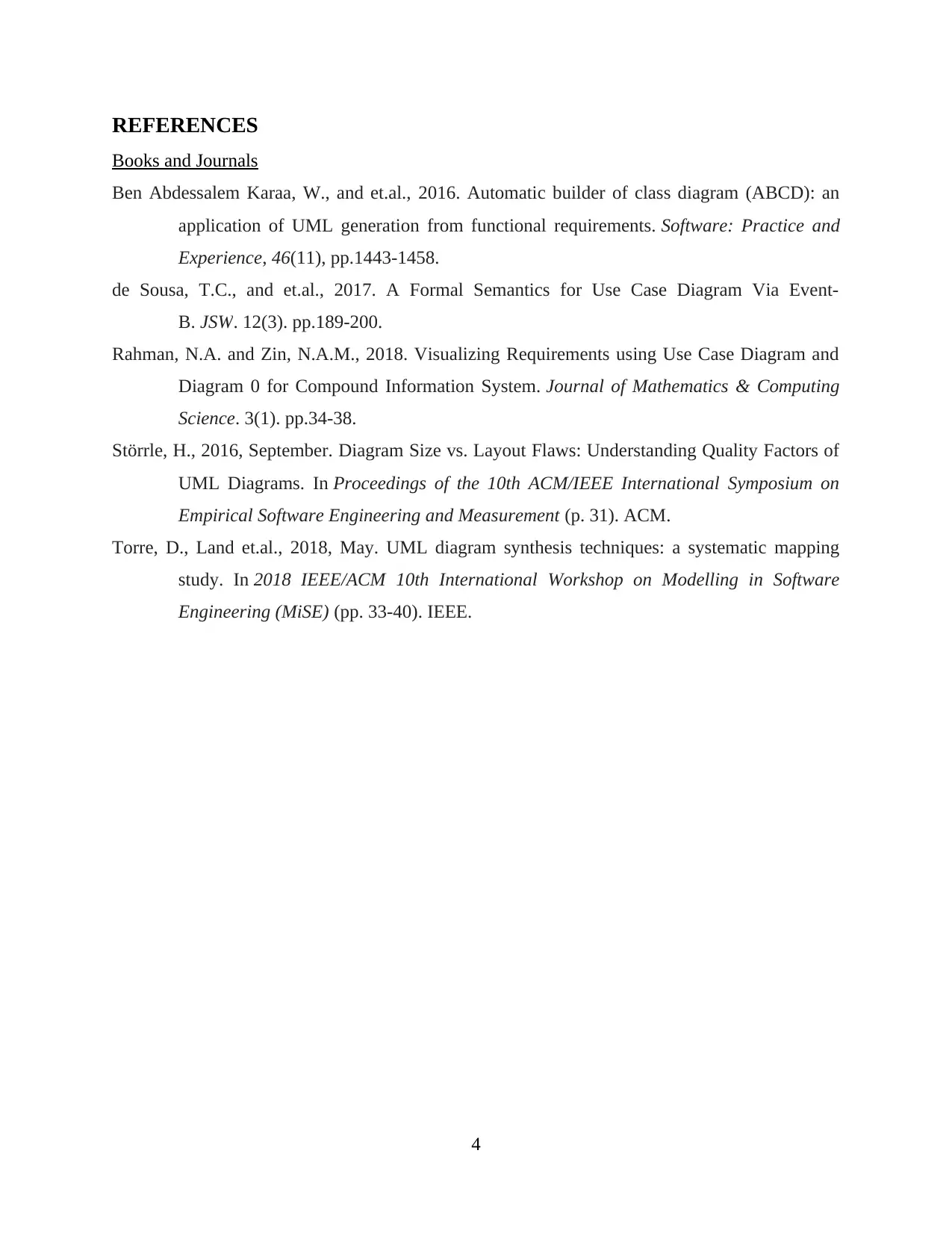
REFERENCES
Books and Journals
Ben Abdessalem Karaa, W., and et.al., 2016. Automatic builder of class diagram (ABCD): an
application of UML generation from functional requirements. Software: Practice and
Experience, 46(11), pp.1443-1458.
de Sousa, T.C., and et.al., 2017. A Formal Semantics for Use Case Diagram Via Event-
B. JSW. 12(3). pp.189-200.
Rahman, N.A. and Zin, N.A.M., 2018. Visualizing Requirements using Use Case Diagram and
Diagram 0 for Compound Information System. Journal of Mathematics & Computing
Science. 3(1). pp.34-38.
Störrle, H., 2016, September. Diagram Size vs. Layout Flaws: Understanding Quality Factors of
UML Diagrams. In Proceedings of the 10th ACM/IEEE International Symposium on
Empirical Software Engineering and Measurement (p. 31). ACM.
Torre, D., Land et.al., 2018, May. UML diagram synthesis techniques: a systematic mapping
study. In 2018 IEEE/ACM 10th International Workshop on Modelling in Software
Engineering (MiSE) (pp. 33-40). IEEE.
4
Books and Journals
Ben Abdessalem Karaa, W., and et.al., 2016. Automatic builder of class diagram (ABCD): an
application of UML generation from functional requirements. Software: Practice and
Experience, 46(11), pp.1443-1458.
de Sousa, T.C., and et.al., 2017. A Formal Semantics for Use Case Diagram Via Event-
B. JSW. 12(3). pp.189-200.
Rahman, N.A. and Zin, N.A.M., 2018. Visualizing Requirements using Use Case Diagram and
Diagram 0 for Compound Information System. Journal of Mathematics & Computing
Science. 3(1). pp.34-38.
Störrle, H., 2016, September. Diagram Size vs. Layout Flaws: Understanding Quality Factors of
UML Diagrams. In Proceedings of the 10th ACM/IEEE International Symposium on
Empirical Software Engineering and Measurement (p. 31). ACM.
Torre, D., Land et.al., 2018, May. UML diagram synthesis techniques: a systematic mapping
study. In 2018 IEEE/ACM 10th International Workshop on Modelling in Software
Engineering (MiSE) (pp. 33-40). IEEE.
4
⊘ This is a preview!⊘
Do you want full access?
Subscribe today to unlock all pages.

Trusted by 1+ million students worldwide
1 out of 6
Related Documents
Your All-in-One AI-Powered Toolkit for Academic Success.
+13062052269
info@desklib.com
Available 24*7 on WhatsApp / Email
![[object Object]](/_next/static/media/star-bottom.7253800d.svg)
Unlock your academic potential
Copyright © 2020–2025 A2Z Services. All Rights Reserved. Developed and managed by ZUCOL.





